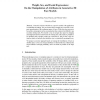Free Online Productivity Tools
i2Speak
i2Symbol
i2OCR
iTex2Img
iWeb2Print
iWeb2Shot
i2Type
iPdf2Split
iPdf2Merge
i2Bopomofo
i2Arabic
i2Style
i2Image
i2PDF
iLatex2Rtf
Sci2ools
ISVC
2009
Springer
2009
Springer
Weight, Sex, and Facial Expressions: On the Manipulation of Attributes in Generative 3D Face Models
Generative 3D Face Models are expressive models with applications in modelling and editing. They are learned from example faces, and offer a compact representation of the continuous space of faces. While they have proven to be useful as strong priors in face reconstruction they remain to be difficult to use in artistic editing tasks. We describe a way to navigate face space by changing meaningful parameters learned from the training data. This makes it possible to fix attributes such as height, weight, age, expression or ‘lack of sleep’ while letting the infinity of unfixed other attributes vary in a statistically meaningful way. We propose an inverse approach based on learning the distribution of faces in attribute space. Given a set of target attributes we then find the face which has the target attributes with high probability, and is as similar as possible to the input face.
| Added | 26 May 2010 |
| Updated | 26 May 2010 |
| Type | Conference |
| Year | 2009 |
| Where | ISVC |
| Authors | Brian Amberg, Pascal Paysan, Thomas Vetter |
Comments (0)

